
Whitesman
-
Posts
44 -
Joined
-
Last visited
Content Type
Profiles
Forums
Events
Posts posted by Whitesman
-
-
Just FYI! I think I am starting to get the picture, no pun intended, about why I am not seeing many or any pictures of the Camp Logan Mutiny of 1917 I have been asking about i.e. the Camp Logan mutineers courts martial proceedings, either the 1st or subsequent courts martial, the gallows, and/or photos of the executions, burning of the gallows after the executions and possibly the graves at Fort Sam Houston where the mutineers were buried. It's because there are either no photos of the kind that I have been looking for, they are being so closely held by the Army or they are so obscure that they are hard to come by.
I have found the people on this website to be some of the best researches you will find anywhere yet so few or maybe none of those photos have turned up by HAIF contributors. I know that some of those photos exist because I have viewed the video of the PBS special on this topic and have seen some of them.
To carry this a step further many years ago I read a copy of "The Night of Violence" by Robert V. Haynes and I remember even years ago having problems getting my hands on a copy of this book. Finally, I had to get a copy of this book through intra-library loan from the University of Michigan and I was living in LA at the time. Recently, I did a search for this out of print book and found it on Amazon.com used for upwards of $100 per copy which I purchased one. And, to my utter surprise there was not one photo in the entire book about, "The Houston Riot of 1917"! There were only 4 hand drawn maps of routes and related locations of the riot and rioters.
So, once again, I ask members of HAIF to contribute any of the photos of interest I have mentioned if they have them in their possession. Thank you.
CampLogan1917

I also have the "Mutiny" book, and another book about Memorial Park, which has a chapter about the riots, but no pictures, just a map of the march route. I also have been searching and have not found any source or any of the pictures, for this event.
Maybe the guy who made the Buffalo Soldier video, Mike Kaliski ,or the media website who hosted the making of the video, bauhausmedia dot com would know ???
The producer must have found the pictures somewhere, to insert into the video.
-
Interesting research & pictures, has anyone tried looking at the Sanborn Insurance Maps on microfilm? I've found those to be of great help when trying to identify property boundaries & owner names. I forget what year they go back to, though. Microfilms can be found along with other materials at The Texas Room at Julia Ideson Library downtown (has a fantastic staff, always eager to lead you in the right direction). The Clayton Geneaology Library in the Med Center is good, too, for Houston research. Nice to know there is a Camp Logan marker, looks like it's new. That feed/water tower is old, I think it could possibly be from that era. I've always noticed how that area's bayou's have been left natural, they are very thick and winding. (Woodway near 610 loop, I-10 at Chimney Rock) I've always wondered why the HPD horse stables are in that particular location, seems odd to me, next to the freeway, (I know, the frwy came later), skinny long piece of land. Thought they would be closer to the polo horse stables. Perhaps the stables have a history linked to the above topics. Because of working in the industry, I agree with the pipeline statement, most chemical multi-lines are kept clear of brush, they have wide right-of-ways, but there are some (mostly single) lines that are sometimes hard to access. IMO Winter-time in this city is the best time to hunt for hidden structures, with the absence of jungle vegetation.
Up until the early 1960's, you could rent a horse to go riding on the trails, through Memorial Park( before mountain bikes were popular), and I believe the stables were taken over by the Police Dept.afterwards, for their horses.
Just a thought on the water/tank building.. if the water tower is newer than the Camp, why would someone have built it,after Camp Logan, in an area that the owner had given the land to the city, that would strickly be used as park area built in 1925??
Whitesman
-
Whitesman,
Thank you! That's a great photo of the Texas Historical Commission Camp Logan Historical Marker. Where exactly did you find that marker? I looked but it but I couldn't find it.
Thanks, again.

CampLogan1917
CampLogan1917,
I did some extra searching on the riot, and remembered reading, that blacks were called "Buffalo Soldiers", so I Googled "Buffalo Soldier Mutiny" and some good hits came up.
One even has a short film made of the riot, by Mike Kaliski, and you can download the film for about 10 dollars.
"Buffalo Soldier Mutiny"
on the following website:
www dot zipidee dot com
-
Whitesman,
Thank you! That's a great photo of the Texas Historical Commission Camp Logan Historical Marker. Where exactly did you find that marker? I looked but it but I couldn't find it.
Thanks, again.

CampLogan1917
The marker is at Arnot and Haskell in a small section between the streets.
-
Nice article, . .......I'm still trying to track down a photo of the Camp Logan Historical Marker but no luck so far.
CampLogan1917
This should help.

-
The GPS coordinates that my phone reported for this location to be 29.7628N, 95.4584W which I turned into a GoogleEarth satellite map... I'm very curious to the full nature and history of the path that leads down through the middle of this stretch of Memorial Park. While the path clearly goes very close to these old remants of Camp Logan, they don't go close enough to what I'd call a 'driveway' to them nor is the path efficient enough to be considered a maintenance path to the pipeline and telephone pole lines that slice through the very bottom (south) edge of this park land.

.
The road was used for the archery range and right after the archery range is a bigger clearing where a car could turn around and go back up the one lane dirt/crushed shell road. There is one or two picnic tables left from the archery range days and you can find parts, and full arrows all over that area.Parts of the where you stood to shoot the arrows( like the gun shooting practice stalls you see on TV) and the target holders are still in the woods.
There is a pathway that goes in front of the structure , but has been overgrown with brush for many years.
-
Whitesman,
What fabulous 1st hand research on the ruins of Camp Logan you did. I was fascinated by the photos and your words describing your search and adventure along with the topo map, Google Map and your insights about something that existed so long ago.
CampLogan1917
Credit also goes to Mr. Jackson who had his own adventure, locating the structure with excellent pictures, topo map,and his insights on the structure..
According to few people, who know bricks and have looked at some pictures that I took,of the bricks,morter thickness, and the structure , the bricks and this structure are at least 80-100 years old. And indeed ,could have been past the Camp Logan time.
But why build a water tank on the edge of a piece of land that was to be used for a part of a park??
Remember.... 610 and I-10 were not built in 1925, and this section, was a main park of the park and of the Camp, even though the online "Gill" map doesn't include this area.
A couple of different sources say the main camp developed area , which is most of the online map,( ..."Camp site proper was 2000 acres with the Remount Depot"-- From the book "Memorial Park-A Priceless Legacy") was just part of the complete camp area.
The structure could have been made for the National Guard camp that Camp Logan took over, or for Camp Logans Remount Depot. The last picture Mr. Jackson took in his post shows very well the type of bricks of this storage/water tank structure.
Can anyone else, who knows about brick laying, give an approximate date of this water tank/storage building, by looking at the pictures Mr. Jackson took of this structure???
-
I went out to investigate the old Camp Logan remains mentioned in the old newspaper article about them possibly being in the abandoned stretch of Memorial Park just west of the 610 Loop West. I went this morning while the weather was nice and wasn't too hot. Finding the trail and getting started was very easy, and with a GPS phone with satellite imagery with me, I guess you could say I was cheating by looking for the reported remains. I got to about approximately 80 yards of the 100 yard path leading down the turn off, when large freshly downed trees made it impossible to continue without drifting off newspaper article described path considerably..

[ Looking at gate, N toward Woodway.]

[ Looking S toward downed trees.]
After turning to the west toward the reported "path" and clearing, which at this point was only a very short slightly downhill jog toward the bayou, I had to continue skimming the often sandy bayou beach until I reached a point along the bayou where there was what appeared to be a dry stream bed of some type leading to the bayou. It was at this point that the Camp Logan remains were only a short walk away. Once passing the dry stream bed, the embankment climbed steeply up a hill in the S/SSE direction where the remains were located...

[ Looking SE toward the back side of the Camp Logan remains. The front and front door of both the feed tank (or whatever it is) and the shed next to it face directly toward the path, provided I had been able to stay on the path. You can see the straight line in the satellite imagery that make up the walking path, but Hurricane Ike clearly hasn't been nice to these parts, with the path far harder follow and make out this deep into the forrest. ]

[ Closer shot of behind remnants...]

[ Side of shed next to feed tank.]

[ Front door of shed next to feed tank.]

[ Inside the shed next to the feed tank. The milk carton is a sure sign that others have visited here, or even tried to live here.]


[ Camera facing down inside bricked base of feed tank toward front door.]
Well, I was hoping for myself to have a clearer idea whether or not I believed this to be the last remains of Camp Logan. My hunch tells me that these are NOT the remains of Camp Logan, but more likely the remains of another property owners storage shed and feed tank just west of the old Camp Logan camp and property. We know the fairly precise boundaries of the old Camp Logan training base and it's all been documented in carefully drawn out maps, and I have a hard time believing that this area, this far from Camp Logan central, is connected to it in any way. It's certainly possible..
The GPS coordinates that my phone reported for this location to be 29.7628N, 95.4584W which I turned into a GoogleEarth satellite map... I'm very curious to the full nature and history of the path that leads down through the middle of this stretch of Memorial Park. While the path clearly goes very close to these old remants of Camp Logan, they don't go close enough to what I'd call a 'driveway' to them nor is the path efficient enough to be considered a maintenance path to the pipeline and telephone pole lines that slice through the very bottom (south) edge of this park land.


I also found this topographic map on Microsoft TerraServer that shows the land as it was topo'd back in 1982, so 26 years ago and counting, and I found it interesting that the topographic map clearly shows the path going south for a good distance before the map fails to continue drawing it, but the location of a structure is clearly shown and identifies it at the top of a hill. The part that is strange about this is that the structure indicated shows it immediately next to and at the end of the path, yet the current location is considerably further west and slightly north of this location. Notice also the small 'lake' shown just south of the bayou right above the "50" foot elevation marker, yet this current location is home to tennis courts and condo's along the posh Riverway Drive.
The structure on the topo map is (was) a pavillion,was burned down, used for the archery range that was used until the early 1980's. The hotel across the bayou (directly south) was getting overshot arrows in their parking lot so they had that area of the park shut down as it was in need of repairs due to bank erosion.
___________________________________________
Acorrding to Louis F. Aulbach ,about Camp Logan:
The developed area of Camp Logan was 3002 acres, within a tract of 9560 acres.
A remount depot was constructed just west of the main camp.
A rifle range was built 8 miles west on Hillendahl Rd.
Paved roads were oyster shell or cinder.
____________________________________
The downed trees blocked your way to see the pavillion on the right side of the path, (the topo map shows it correctly.)
The archery range was on the west side of the trail on the north side of the buned down pavillion.Under the leave covering of the path you were on is remnants of oyster shell roadways that are all over that secluded section.
The area is just west of the main camp and since there is a large water tank constructed there, would have been a good place for an extra remount depot where horses could get water pumped up from the bayou right behind the water tank.There is a small flat concrete slab behind the tank which could have held the pump. The area was pretty much treeless 90 years ago and was farmland, so an area, off the main camp would be good to have some extra horses. Memorial park is just about 1500 acres. According to "Memorial Park A Priceless legacy, Camp Logan covered over 7500 acres in size.
-
When I was doing my book on Houston streetcars I really wanted to find a photo of the streetcar turning loop at Camp Logan, but never found one. It was located at the edge of the camp near the corner of Ariel and Cohn streets, apparently across from the camp YMCA building. Surely some soldier took a snapshot of the streetcar. If anyone has such a photo I would love to see it.
Anyone know the location or have a picture of where the Camp Logan Drugstore was located at???
-
The above picture is not the last structure from the Camp.On August 23, 1917, two white policemen arrested a black soldier for interfering with their arrest of a black woman. When a black MP inquired about the soldier's arrest, words were exchanged, & one of the policemen struck the MP. The MP fled; & while fleeing, the MP was fired upon. The MP was pursued into an unoccupied house, where he was arrested & brought to police headquarters. Despite a quick & unhindered release, a rumor rapidly reached Camp Logan that the MP had been shot & killed. After several minutes of mounting tension, the rumor mill brought word to camp that the MP was in fact alive but being held unlawfully. After intense debate, a group of soldiers conclude to march onto the police station in Fourth Ward & secure the MP's release. If the police could assault model soldiers like the military police, they reasoned, none of them were safe from abuse. Realizing something foul was afoot, the white officers of the company ordered the collection of all rifles & loose ammunition. During this process, word of an approaching white mob struck fear into the hearts of the men. In a wild scurry to defend themselves, the soldiers rushed into the supply tents, grabbed rifles & ammunition, & then embarked on a two-hour march into the city, hoping to curb the mob. The white officers found it impossible to restore order. Over a 100 armed soldiers marched into the Fourth Ward, where they encountered the mob: members of which consisted of Klansmen & supporters, police officers, & members of Houston's elite white class, who saw armed blacks as a threat to their ruling order. There was an intense exchange of fire, lasting for several minutes, which resulted in the death of many people. The structure in the picture was the last remains from Camp Logan but it is gone, too, now.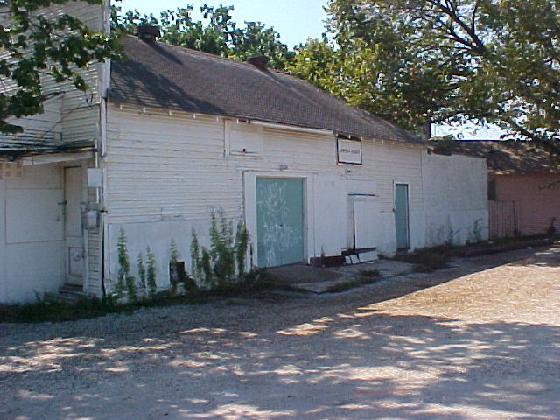
CampLogan1917
From this old Houston Post article below,I had found,this water tank and brick structure was still intact as of earlier this year (2008), I took a few pictures of it and it IS still there.
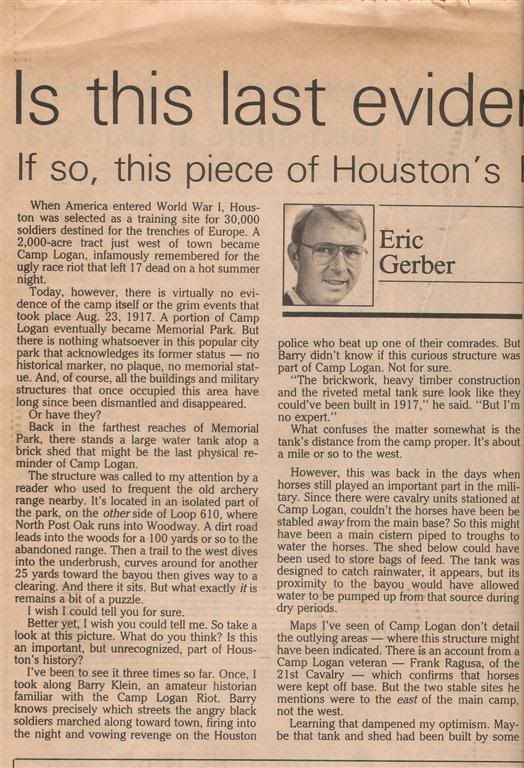
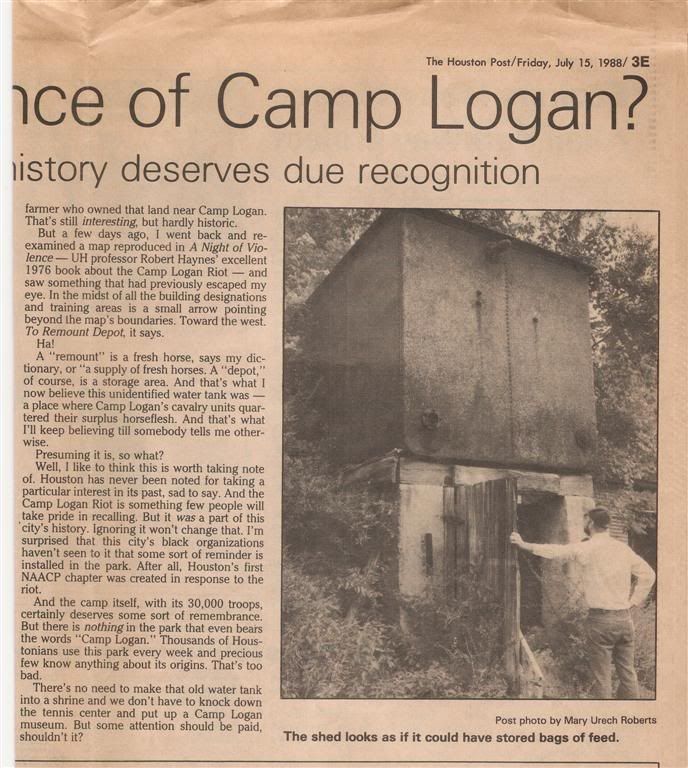
I had emailed the author of this article and he stated that a few "experts", looked at the structure, but no final conclusion was made,as to if it was or was not , a Camp structure.
In the thread of Camp Logan pictures I posted a link to my 40+ Camp Logan postcard/pictures on my Photobucket site.
-
I've been reading Rick Campbell's blogs. Loved the blogs on Fever Tree. I was a big fan.
Me too... still got the LP's. I saw Fever Tree at the Living Eye on Silber Road way back.......Also the Moving Sidewalks, Billy Gibbons' band before ZZTop.
Great memories!!!
-
I suspect David Kaplan is the same guy who started this whole conversation a long time back. Countless kids who went to Houston schools in the 40s, 50s and early 60s had no problem with swimming in the nude at junior high school, and if they did have a problem with it they kept it to themselves, and they don't sit around whining about it now the way this guy Kaplan is doing.
I'm sorry he was embarrassed, but he needs to get over it. Good grief.
As I went to Black jr. high and Waltrip sr. high in the mid to late 1960's, swimming naked in the pool during a P.E. class was a mandatory thing, to learn how to do some basic swimming. I particulary didn't like it, but as it was "required" I did it and got over it.
I do remember 1 time where the boys were in the pool and the girls P.E. class started to come in with their coach. About a half dozen girls came in and then were quickly ushered out again. They had swimsuits on.
I bet those first few girls got a peek of the guys that were hanging on the diving board.

-
Camp Logan was a hastily assembled, temporary camp for training soldiers during WWI, and I seriously doubt that they would have a cemetery dedicated solely for the few soldiers that would have died during training or during treatment at Camp Logan Hospital. Since this was an Illinois Guardsman camp, any casualties would have, most likely, been returned home. Unlike Fort Sam Houston that has been around for 140 years (40 years at the time of WWI), Camp Logan existed less than two years and would have no need for a veterans/military cemetery.
Before it was a WW1 training camp, the area was a National Guard training camp. And the camp hospital building was in use until 1925. Agreed that most of the soldiers trained there were from Illinois, but many from the Houston/Galveston area also were trained there also.
-
I read on another website that there was a Camp Logan Cemetary, just for the soldiers, about 1- 2 miles east of the camp location, close to where Blossum Street runs east/west.
Does anyone know any information about this cemetary??
-
How about Robert Hall Clothiers???
My parents bought me a suit from here in the early 1960's.
Or Thom McAn Shoe stores??
I used to like this shoe store.
-
Past Shopping Places in Houston That Are No Longer Here.
Name places you can remember.
Anyone remember Robert Hall Clothiers??
My parents took me to one of these to get a suit way back in the early 1960's.
How about Thom McAn Shoes?????
I used to like this store.
-
I have aquired some postcards and gotten some pictures of the Camp, on my photobucket site. I hope to get some more in the up coming months. If anyone has some they would like to share that I don't have, could you please PM me. I would like to add some more to my folder.
I live less than 3 miles from that area.
Thanks.
http://s119.photobucket.com/albums/o135/Wh...n/Camp%20Logan/
-
The area you describe was wooded at the time (still is). I don't see any evidence of that in the photo. And that looks like the Eureka Crossing of the Washington Road in the backgroud. Another point is that Old Katy Road crossing was just above the fork or junction. The soldier photo shows two clearly separated tracks with the road crossing still ahead. The track on the right in my photo does curve off to the right, although that may not be visible in the photo I posted. The photo I took would also have been close to the Eureka Station which seems a more likely place for a soldier to be who might have been coming from or going into Houston on the train. There wasn't anything in the area you described execpt a grove of trees which are not visible in the photo.
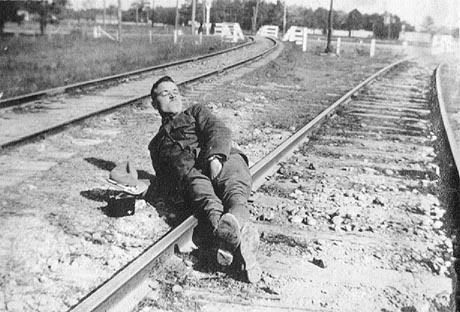
This map was drawn while Camp Logan was still intact

I have metal detected in the area where Old Katy Road crossed the R/R tracks. I have also been to where the Eureka Road crosses the tracks also. I have 2 pictures of the spot at Old Katy Road and the tracks taken last year. One was taken on the east side of the tracks, and one was taken on the west side of the tracks.Both were taken just on the north side of where Old Katy Road crossed the R/R tracks. The soldiers picture was taken on the east tracks, on the north side of Old Katy Road.
That is the only spot where the tracks curve outward at both tracks.It is on the map you show posted. The small curved tracks just on the south side of the Old Katy Road were part of Camp Logan also.
The old Katy Railroad tracks ( now gone) can be seen in the background of the soldiers picture laying on the tracks.

-
Here is a "Then and Now" photo of the area where the soldier is lying on the RR tracks:
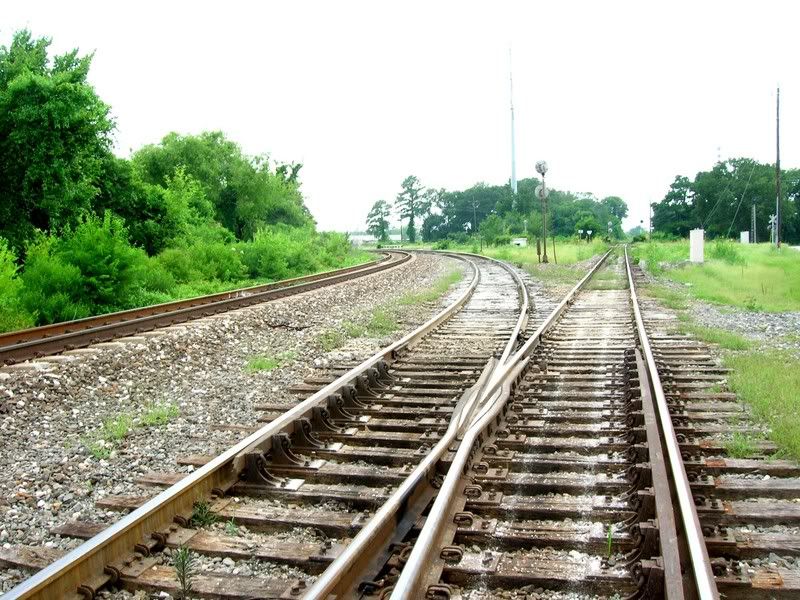
I hate to say this, but that is not where the soldier laid on the R/R tracks. If you look at the old picture where the guy is on the tracks,the tracks on the right side of the picture curve toward the right. The tracks on the left side of the picture curve out toward the left. Only one area in Camp Logan had the tracks like that, on the north side of where Old Katy Road crossed Washington Road.
Over the past few years of internet collecting, I've scrounged up quite a fewpictures of Camp Logan. I haven't seen much listed on it, so I thought I would
throw a few on. Here are 15 of them.. I also have a detailed map of the camp
that was drawn by a map maker soldier who was there.
The writing you see on the pictures is backwards, but the image itself is
the right way. It's only the writing that is backwards.
Sorry if these dupe any others might have already posted..
I get these from various sites.. Many came from the library of congress,
but some came from other sites.
I've got more, but I don't want to bog you all down at one time..
I'm on cable now, so pretty zippy, but I realize it can take a while
for a dial up to load the page.. So I better not get too carried away..
MK















I have accumulated over 30 pictures/postcards of Camp Logan.
-
I just thought of another road that was covered up to make way for an extension - Eldridge Parkway north of 1960 makes a bend just south of Cypress North Houston Road. This curved section was formerly a street called Susquannah (not sure of spelling).
Another obscure one was when the Antoine extension was built from 290 to Hempstead Road, it went over the top of a tiny street called either March or May Street. April Street still exists a couple blocks down.
Does anyone know why Ora Street was closed? It's a short street near Dacoma and Hempstead. I've seen other funny things with sections of streets barricaded.
Wow that was great about all those streets. Here's another good bit of trivia - the Gulf Freeway was never a "full freeway" until the 70s. Highways with crossovers are not freeways.
I have some web sites of abandoned highways, bridges and "lost" highways if anyone might be interested. I have also been thinking about taking pictures of abandoned streets in the Houston area if there was any interest - I know of at least a dozen places where the concrete remains from old roadways - North Houston Rosslyn, Perry Road, FM 529 just to name some.
Ora Street was closed after one of the businesses close to the road bought the land. It is now private. there used to be an old wodden home on the road on the right side and befroe the land was sold the house was in terrible condition it was torn down.
-
Many old Houston city maps have Breen Road listed as Mulberry Street. Was the named changed, possibly around 1965 or 66? Why was the name of the road changed?
I know many other roads in Houston had names changed - South Park to MLK, ?? to Sgt. Macario, even T. C. Jester was originally called White Oak Drive.
Sometimes pieces of roads were absorbed into longer roads when the extensions were built. Antoine took over a short street called Oxbow, T.C. Jester took over a street called Telford. T. C. Jester took over Leroy Street. etc. any other examples? probably many!
Mangum Road used to be called White Oak Drive.
W. T.C. Jester was Teleford, I have lived right off of W.T.C. Jester and W.34th Street since 1958.
W.34th from Shepherd going west to Oak Forest, then north to W.43rd, then west to Mangum Road, then north to Acorn, then to west to Antoine, then north to Pinemont.....used to be the original Rosslyn Road. It is on a 1950 Map that I have.
-
There was a Chuck Wagon on W. 34th st. next door to Waltrip High School, about the 1300 block. I know that it was in operation from the mid 50's until around 1968, likely longer than that.
Wheel Burgers were $.35, Hub Brurgrs were $.25 and Spokes were $.25. They had the best tater tots ever made. When you called to place an order, they answered the phone Chuck Wagon #9. The location is now an abandoned auto repair.
The only better hamburger I ever had as a kid was at Linder Lake. Now that goes back a long, long time.
There is still an old building on Broadway that has the wagon top. I'll see if I can get a pic.
In the 1980's the owners son of that property, had a type of flea market there ,where you could trade items you had, for items they had, and he also sold some metal detectors.You could also commission what you had to sell or he would buy it or trade.
After he left the location, a few years later the Auto Repair shop opened up.
I used to go to Waltrip in the late 60's and remember ordering a "Suicide" soft drink at the Chuck Wagon. You got a little of each flavor of soft drinks they had, and 3 straws to drink it.
I swear you could taste each flavor out of the individual straws!!!!!




Historic Houston Amusement Parks & Places
in Historic Houston
Posted
I remember going there.
It had pony rides and also some trampolines set into the ground.
I remember the red/white tent and I think it was Playland Park... but I could be wrong on the name.
I think it was just north of Pinemont????....it had lots of trees if I remember correctly.